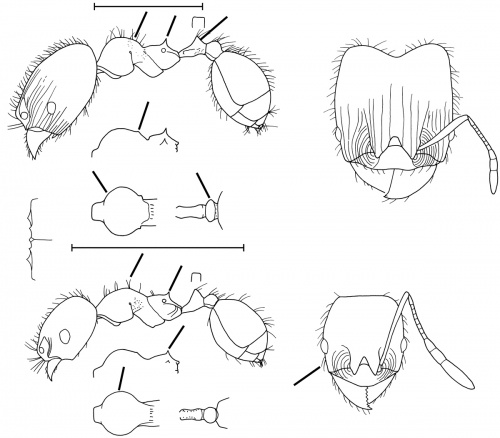Pheidole terresi
| Pheidole terresi | |
|---|---|

| |
| Scientific classification | |
| Kingdom: | Animalia |
| Phylum: | Arthropoda |
| Class: | Insecta |
| Order: | Hymenoptera |
| Family: | Formicidae |
| Subfamily: | Myrmicinae |
| Tribe: | Attini |
| Genus: | Pheidole |
| Species: | P. terresi |
| Binomial name | |
| Pheidole terresi Wheeler, W.M. & Mann, 1914 | |
| Synonyms | |
| |
From Wilson (2003): In Haiti, the type colonies were recorded as nesting in soil (W. M. Mann), while in the Dominican Republic, the Constanza colony was found beneath a rock in a pine-hardwood forested ravine (W. L. and D. E. Brown).
Identification
See the description in the nomenclature section.
Keys including this Species
Distribution
Hispaniola, recorded from both Haiti and the Dominican Republic, within 800–1600 m. An apparent endemic. (Wilson 2003)
Latitudinal Distribution Pattern
Latitudinal Range: 19.61° to 18.02571°.
| North Temperate |
North Subtropical |
Tropical | South Subtropical |
South Temperate |
- Source: AntMaps
Distribution based on Regional Taxon Lists
Neotropical Region: Dominican Republic, Greater Antilles, Haiti (type locality).
Distribution based on AntMaps
Distribution based on AntWeb specimens
Check data from AntWeb
Countries Occupied
| Number of countries occupied by this species based on AntWiki Regional Taxon Lists. In general, fewer countries occupied indicates a narrower range, while more countries indicates a more widespread species. |

|
Estimated Abundance
| Relative abundance based on number of AntMaps records per species (this species within the purple bar). Fewer records (to the left) indicates a less abundant/encountered species while more records (to the right) indicates more abundant/encountered species. |

|
Biology
Castes
Nomenclature
The following information is derived from Barry Bolton's Online Catalogue of the Ants of the World.
- illota. Pheidole terresi var. illota Wheeler, W.M. & Mann, 1914: 23 (s.w.) HAITI. Junior synonym of terresi: Wilson, 2003: 523.
- terresi. Pheidole terresi Wheeler, W.M. & Mann, 1914: 22 (s.w.q.) HAITI. Senior synonym of illota: Wilson, 2003: 523.
Unless otherwise noted the text for the remainder of this section is reported from the publication that includes the original description.
Description
From Wilson (2003): DIAGNOSIS A medium-sized, concolorous yellow member of the flavens group distinguished in both major and minor by the almost complete absence of sculpturing over the entire body (which is thus smooth and shiny), except for longitudinal carinulae on the anterior half of the head capsule. Further, in the major: a weakly developed but distinct mesonotal convexity in dorsal-oblique view, petiolar node triangular in side view, postpetiolar node subangulate from above.
Minor: pilosity sparse and short, propodeal spine shaped like an equilateral triangle.
Similar species: Pheidole amabilis, Pheidole boliviana, Pheidole melastomae, Pheidole mixteca, Pheidole scitula and especially Pheidole crinita and Pheidole similigena.
MEASUREMENTS (mm) Lectotype major: HW 0.84, HL 0.90, SL 0.42, EL 0.08, PW 0.40. Paralectotype minor: HW 0.38, HL 0.44, SL 0.38, EL 0.06, PW 0.24.
COLOR Major: concolorous clear medium yellow, except for gaster and appendages, which are light yellow.
Minor: concolorous pale yellow.
Figure. Upper: major. Lower: minor. Scale bars = 1 mm.
Type Material
Diquini, Haiti. Museum of Comparative Zoology (Wilson 2003)
Etymology
Named after J. B. Terres, one of William M. Mann’s hosts in Haiti. (Wilson 2003)
References
- Wilson, E. O. 2003. Pheidole in the New World: A dominant, hyperdiverse ant genus. Harvard University Press, Cambridge, MA. (page 523, Senior synonym of illota, fig. major, minor described)
- Lubertazzi, D. 2019. The ants of Hispaniola. Bulletin of the Museum of Comparative Zoology, 162(2), 59-210 (doi:10.3099/mcz-43.1).
- Wheeler, W. M.; Mann, W. M. 1914. The ants of Haiti. Bull. Am. Mus. Nat. Hist. 33: 1-61 (page 22, soldier, worker, queen described)
References based on Global Ant Biodiversity Informatics
- Kempf, W.W. 1972. Catalago abreviado das formigas da regiao Neotropical (Hym. Formicidae) Studia Entomologica 15(1-4).
- Perez-Gelabert D. E. 2008. Arthropods of Hispaniola (Dominican Republic and Haiti): A checklist and bibliography. Zootaxa 1831:1-530.
- Wheeler W. M., and W. M. Mann. 1914. The ants of Haiti. Bulletin of the American Museum of Natural History 33: 1-61.
- Wilson, E.O. 2003. Pheidole in the New World: A Dominant, Hyperdiverse Genus. Harvard University Press



